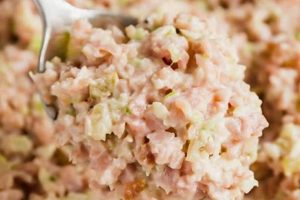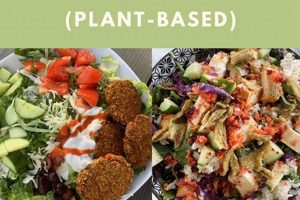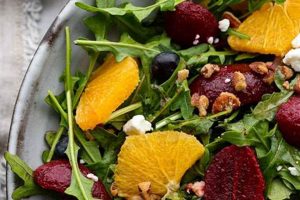Warm or hot salads feature cooked ingredients, often combined with fresh elements. Examples include wilted spinach salad with warm bacon dressing, grilled chicken salad with roasted vegetables, or a German potato salad with a vinegar-based dressing. These preparations offer a departure from traditional cold salads, providing different flavor profiles and textures.
Incorporating cooked components can enhance the nutritional value of a salad by making certain nutrients more bioavailable. Additionally, the warmth of cooked salads can be particularly appealing during colder months, offering a comforting and satisfying meal. Historically, warm salads have been a part of numerous cuisines worldwide, reflecting cultural preferences and seasonal ingredient availability. From ancient Roman recipes to modern culinary innovations, the concept of a cooked salad has persisted and evolved.
The following sections will explore various types of cooked salads, offering specific recipes and discussing key culinary techniques for achieving optimal results. Nutritional information and variations will also be provided to cater to different dietary needs and preferences.
Tips for Preparing Warm Salads
Creating flavorful and satisfying warm salads requires attention to both the cooked and raw components. The following tips offer guidance for achieving optimal results.
Tip 1: Balance Temperatures: Avoid combining piping hot ingredients with delicate greens, as this can cause wilting. Allow cooked items to cool slightly before incorporating them into the salad.
Tip 2: Consider Texture: A variety of textures enhances the overall dining experience. Combine crisp lettuce with roasted vegetables, toasted nuts, or seared protein for a more interesting mouthfeel.
Tip 3: Ingredient Selection: Heartier greens, such as kale or spinach, hold up well when combined with warm ingredients. Delicate greens like butter lettuce are best suited for salads with room-temperature components.
Tip 4: Dressing Application: The temperature of the dressing should complement the salad. Warm dressings are often ideal for warm salads, while lighter vinaigrettes might be preferred for salads with room-temperature elements.
Tip 5: Seasoning: Season cooked ingredients individually before incorporating them into the salad. This ensures a more balanced and flavorful final dish.
Tip 6: Proper Storage: While some cooked salads can be stored in the refrigerator for a short period, it’s generally best to consume them immediately after preparation for optimal flavor and texture.
Tip 7: Presentation: Consider the visual appeal of the salad. Arrange ingredients thoughtfully to create a visually engaging dish.
By following these tips, one can elevate warm salads from simple meals to culinary creations that are both satisfying and visually appealing.
These guidelines provide a solid foundation for exploring the diverse world of warm salads. The following section delves into specific recipe examples, showcasing the versatility and delicious possibilities of this culinary approach.
1. Warm Ingredients
Warm ingredients form the foundation of cooked salads, distinguishing them from their cold counterparts. The application of heat transforms ingredients, altering their textures, intensifying flavors, and increasing the bioavailability of certain nutrients. This transformation plays a pivotal role in the overall sensory experience and nutritional profile of the dish. For instance, roasting vegetables caramelizes their sugars, creating a depth of flavor not present in their raw state. Similarly, grilling or searing proteins develops desirable textures and imparts smoky notes. These changes contribute significantly to the unique character of cooked salads. The interplay between warm and cool components creates a dynamic textural and flavor experience absent in traditional cold salads.
The choice of warm ingredients dictates the overall flavor profile and nutritional composition of the salad. Grilled chicken or fish provides lean protein, while roasted root vegetables contribute fiber and complex carbohydrates. The careful selection of these ingredients allows for tailored nutritional outcomes and diverse culinary experiences. A warm lentil salad with roasted sweet potatoes, for example, offers a hearty and nutritious vegetarian option. Alternatively, a seared tuna salad with warm quinoa showcases a lighter, protein-rich alternative. The versatility of warm ingredients allows for endless variations, accommodating dietary preferences and culinary creativity.
Understanding the impact of warm ingredients on both flavor and nutrition is crucial for creating successful cooked salads. This knowledge empowers culinary exploration and allows for the development of dishes that are both satisfying and nutritionally balanced. While temperature contrast adds complexity, careful consideration of ingredient compatibility and cooking methods remains essential for optimal results. Balancing these elements elevates cooked salads beyond simple meals, transforming them into dynamic culinary creations.
2. Varied Textures
Textural diversity significantly enhances the sensory experience of cooked salads. The interplay of contrasting textures elevates these dishes beyond simple meals, creating a more dynamic and engaging culinary experience. The strategic combination of crisp, tender, crunchy, and creamy elements adds depth and complexity, making each bite more satisfying.
- Crisp Elements
Crisp elements provide a refreshing counterpoint to softer, warmer ingredients. Raw vegetables such as romaine lettuce, shredded carrots, or sliced cucumbers offer a satisfying crunch. Toasted nuts or seeds contribute a different type of crispness, adding another layer of textural complexity. In a warm quinoa salad, toasted almonds provide a pleasant contrast to the soft quinoa and roasted vegetables.
- Tender Components
Tender components, often the cooked elements of the salad, contribute a softer texture. Roasted vegetables, grilled chicken or fish, or wilted greens offer a delicate contrast to crisper elements. For example, in a warm spinach salad with bacon, the tender spinach complements the crisp bacon and croutons, creating a balanced textural experience.
- Crunchy Additions
Crunchy additions provide a pronounced textural contrast. Croutons, toasted nuts, or crispy fried onions offer a satisfying crunch that enhances the overall sensory experience. Adding croutons to a Caesar salad with grilled chicken provides a satisfying crunch against the tender chicken and romaine lettuce.
- Creamy Textures
Creamy textures offer a richness and smoothness that complements other textural components. Avocado, crumbled cheese, or a creamy dressing contribute a luxurious mouthfeel. In a warm lentil salad with roasted vegetables, a dollop of goat cheese adds a creamy element that balances the other textures.
The thoughtful integration of these varied textures transforms a simple cooked salad into a multi-dimensional culinary experience. The interplay of contrasting textures elevates the dish, creating a more satisfying and memorable meal. By considering the textural profile of each ingredient, one can create cooked salads that offer a complex and delightful sensory experience. This attention to texture is a key factor in creating salads that are both visually appealing and enjoyable to eat.
3. Flavor Balance
Flavor balance is paramount in cooked salad recipes. Success hinges on the harmonious interplay of tastessweet, sour, salty, bitter, and umamicreating a cohesive and satisfying whole. Disproportionate flavors can lead to a dish that is overly sweet, excessively acidic, or bland. The cooking process itself influences flavor profiles; caramelization during roasting intensifies sweetness, while searing develops savory notes. Consider a roasted butternut squash salad: the inherent sweetness of the squash is balanced by the peppery bite of arugula and the tangy acidity of a vinaigrette. This careful orchestration of flavors prevents any single taste from dominating, resulting in a well-rounded and enjoyable dish.
Achieving flavor balance requires a nuanced understanding of ingredient interactions. Complementary flavors enhance one another, while contrasting flavors create complexity. For example, the richness of grilled halloumi cheese pairs well with the sweetness of roasted figs, creating a harmonious flavor profile. Conversely, the bitterness of radicchio can be balanced by the sweetness of roasted pears and the creamy richness of a walnut dressing. Furthermore, the temperature of ingredients plays a crucial role. A warm salad necessitates careful consideration of how heat affects flavor perception; certain flavors may become more pronounced or muted at higher temperatures. Therefore, adjustments in seasoning and ingredient ratios may be required to maintain equilibrium.
Mastery of flavor balance elevates cooked salads from simple meals to sophisticated culinary creations. It demonstrates an understanding of the complex interplay of tastes and textures, transforming individual ingredients into a harmonious whole. Challenges arise when incorporating diverse ingredients with varying flavor profiles. Overcoming these challenges requires careful consideration of ingredient pairings, cooking methods, and the interplay of temperatures. Successfully navigating these complexities allows for the creation of dishes that are not only nutritionally sound but also offer a complex and rewarding sensory experience, reflecting a nuanced understanding of culinary principles.
4. Nutritional Value
Nutritional value represents a significant advantage of cooked salads. Cooking certain vegetables enhances nutrient bioavailability. Fat-soluble vitamins, such as vitamins A, D, E, and K, become more accessible when vegetables are lightly cooked in healthy fats. Lycopene, a potent antioxidant found in tomatoes, exhibits increased bioavailability after cooking. The gentle heat breaks down cell walls, releasing nutrients otherwise trapped within the plant’s structure. This process optimizes nutrient absorption, making cooked salads a potentially more nutrient-rich option than salads composed solely of raw vegetables. For example, a warm spinach salad with roasted red peppers provides higher levels of accessible vitamins A and C than a salad with raw spinach and peppers.
Strategic ingredient selection further amplifies the nutritional benefits. Incorporating protein-rich foods, such as grilled chicken, fish, or legumes, enhances satiety and contributes essential amino acids. Adding whole grains like quinoa or farro increases fiber and complex carbohydrate content, promoting digestive health and sustained energy levels. Healthy fats from sources like avocado, nuts, and seeds provide essential fatty acids crucial for various bodily functions. Consider a cooked salad with grilled salmon, roasted broccoli, and quinoa: this combination delivers a potent dose of omega-3 fatty acids, vitamins C and K, and fiber, offering a nutritionally complete meal. Careful consideration of ingredient pairings allows for the creation of salads tailored to specific dietary needs and health goals.
While cooking enhances the bioavailability of certain nutrients, it can also diminish others if not executed properly. Water-soluble vitamins, such as vitamin C and B vitamins, are susceptible to leaching during cooking. Minimizing cooking time and using methods like steaming or quick sauting helps preserve these vital nutrients. Understanding these nuances allows for informed culinary choices that maximize nutritional benefits. Balancing nutrient retention with enhanced bioavailability necessitates careful selection of cooking methods and ingredient combinations. This informed approach ensures cooked salads deliver optimal nutritional value, supporting overall health and well-being.
5. Global Influences
Culinary traditions worldwide have shaped the evolution of cooked salads, demonstrating diverse approaches to ingredient combinations, flavor profiles, and cooking techniques. Examining these global influences provides valuable insights into the versatility and adaptability of the cooked salad format.
- Mediterranean Influence
Mediterranean cuisine frequently incorporates cooked salads, showcasing fresh, seasonal ingredients and vibrant flavors. Greek salad, often featuring grilled halloumi or other cheeses, exemplifies this influence. Roasted vegetable salads with olives, feta, and a lemon-herb vinaigrette are also common, highlighting the region’s emphasis on olive oil and fresh herbs. These preparations emphasize simplicity and fresh, high-quality ingredients.
- Asian Inspiration
Asian-inspired cooked salads often incorporate stir-fried or seared vegetables, proteins, and noodles. Warm sesame ginger dressings and the use of ingredients like soy sauce, rice vinegar, and toasted sesame seeds contribute distinct flavor profiles. Examples include Thai beef salad with peanuts and a lime dressing, or a Japanese seaweed salad with sesame oil and mirin. These salads highlight the balance of sweet, sour, salty, and umami flavors characteristic of many Asian cuisines.
- Latin American Flavors
Latin American cuisine offers vibrant cooked salads featuring ingredients like grilled corn, black beans, avocado, and cilantro. Warm salads with grilled chicken or chorizo, often accompanied by a citrus-based dressing, are common. The use of spices like cumin, chili powder, and paprika contributes distinctive flavors. These salads often feature bold flavors and the use of fresh, vibrant ingredients.
- North African Traditions
North African cuisine incorporates warm salads with couscous, chickpeas, dried fruits, and spices like cumin, coriander, and turmeric. Roasted vegetables and grilled meats are often included, reflecting the region’s culinary preferences. These salads frequently feature a combination of sweet and savory flavors, incorporating dried fruits and warming spices.
Exploring these global influences reveals the remarkable adaptability of cooked salads. From the Mediterranean emphasis on fresh simplicity to the complex flavor profiles of Asian cuisine, cooked salads demonstrate a remarkable capacity to incorporate diverse culinary traditions. This global perspective underscores the versatility of this culinary approach, offering a wealth of inspiration for creative culinary exploration.
6. Seasonal Adaptations
Seasonal adaptations maximize the use of fresh, readily available produce in cooked salad recipes. This approach aligns with culinary principles of seasonality, emphasizing the consumption of ingredients at their peak flavor and nutritional value. A spring salad might showcase asparagus and peas, lightly blanched and tossed with a lemon vinaigrette and crumbled goat cheese. In summer, a grilled corn and tomato salad with fresh basil and a balsamic glaze captures the season’s abundance. Autumn brings opportunities for roasted root vegetable salads with maple-glazed pecans and a warm cider vinaigrette. Winter salads can feature roasted Brussels sprouts, kale, and cranberries with a warm Dijon dressing. These examples demonstrate how seasonal adaptations influence ingredient selection, affecting both the flavor profile and nutritional content of the final dish.
Adapting cooked salad recipes to seasonal produce offers several advantages. Flavor profiles benefit from the inherent quality of in-season ingredients, reducing the need for excessive seasoning or manipulation. Nutritional value often peaks during the natural growing season, providing optimal vitamin and mineral content. Supporting local agriculture through the consumption of seasonal produce benefits local economies and reduces the environmental impact associated with long-distance transportation. Furthermore, seasonal adaptations encourage culinary creativity, prompting exploration of new ingredient combinations and flavor profiles. The limitations inherent in seasonal availability can be viewed as opportunities for innovation, pushing culinary boundaries and expanding palates.
Successfully integrating seasonal adaptations requires an understanding of regional growing seasons and ingredient availability. Challenges may arise in areas with limited seasonal variation or during periods of crop scarcity. Resourcefulness and flexibility become crucial in such circumstances. Preservation techniques, such as pickling or freezing, extend the lifespan of seasonal produce, offering opportunities to incorporate seasonal flavors year-round. Ultimately, seasonal adaptations enhance the culinary experience by connecting consumers with the natural rhythm of food production, fostering appreciation for the unique flavors and nutritional benefits each season offers. This connection enriches not only individual meals but also fosters a deeper understanding of the interconnectedness between food, nature, and culinary practice.
Frequently Asked Questions
This section addresses common inquiries regarding cooked salads, providing concise and informative responses.
Question 1: What are the primary benefits of incorporating cooked ingredients into salads?
Cooking enhances the bioavailability of certain nutrients, particularly fat-soluble vitamins. It also allows for broader ingredient variety and offers the opportunity to create more complex flavor profiles.
Question 2: Which types of vegetables are best suited for cooked salads?
Root vegetables, cruciferous vegetables, and leafy greens all benefit from cooking. Specific choices depend on the desired flavor profile and nutritional goals.
Question 3: How can nutrient loss be minimized when cooking vegetables for salads?
Steaming, quick sauting, or roasting are preferred methods for preserving nutrients. Minimizing cooking time and avoiding excessive water exposure helps retain water-soluble vitamins.
Question 4: What are suitable protein sources for cooked salads?
Grilled chicken, fish, tofu, tempeh, lentils, and beans are excellent protein sources. The choice depends on dietary preferences and desired flavor profiles.
Question 5: How can one achieve flavor balance in a cooked salad?
Careful consideration of ingredient pairings, the interplay of contrasting flavors, and appropriate seasoning are essential. Balancing sweet, sour, salty, bitter, and umami elements creates a harmonious taste experience.
Question 6: Are cooked salads suitable for meal prepping?
While some cooked salads can be stored in the refrigerator for a short period, consuming them fresh is generally recommended for optimal flavor and texture. Certain components, such as dressings, may be added just before serving.
Understanding these key aspects of cooked salad preparation allows for greater culinary experimentation and enjoyment. Informed choices regarding ingredients, cooking methods, and flavor combinations ensure both nutritional value and culinary satisfaction.
For further culinary inspiration, explore the recipe section below, which provides detailed instructions for creating a variety of delicious and nutritious cooked salads.
Conclusion
Cooked salad recipes offer a diverse and adaptable culinary approach, transforming perceptions of traditional salad preparations. Exploration of this culinary category reveals the potential for enhanced nutritional value through increased bioavailability of certain vitamins and minerals. The interplay of warm and cool components creates complex flavor profiles and textural experiences not achievable with solely raw ingredients. Global influences and seasonal adaptations further broaden the possibilities, demonstrating the versatility and adaptability of this culinary format. Careful consideration of ingredient selection, cooking methods, and flavor balance ensures optimal results.
The integration of cooked elements in salad preparation represents a significant culinary advancement, expanding nutritional and gastronomic horizons. Continued exploration of diverse ingredients, flavor combinations, and cultural influences promises further innovation within this dynamic culinary space. This approach encourages a deeper understanding of food and its potential to nourish and delight, promoting a more holistic and engaging culinary experience.






